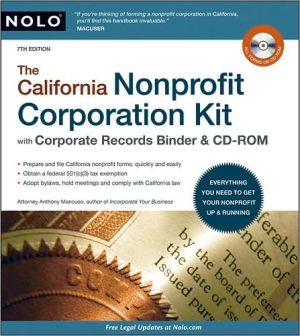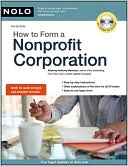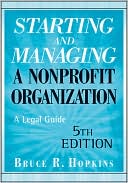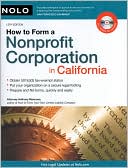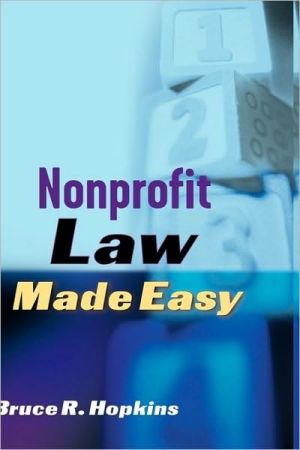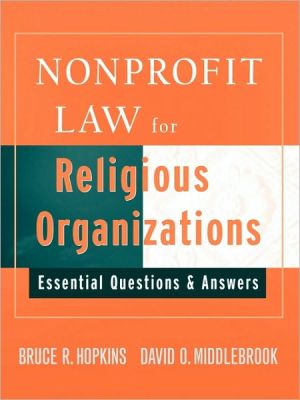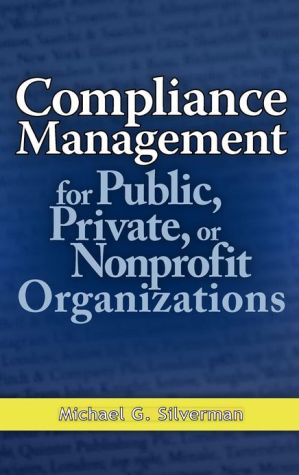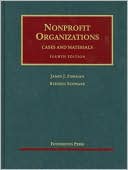The California Nonprofit Corporation Kit
Form a nonprofit and keep everything organized!\ \ Thousands of arts groups, educators, social-service agencies and others have used this bestseller -- which provides a records binder to help keep everything organized -- to organize. It's so easy to use, anyone can do it!\ \ With a nonprofit corporation, you gain recognition, save money, become eligible for grants, and protect your members and directors from liability. And you can do all this without an attorney.\ \ The California Nonprofit...
Search in google:
Form a California nonprofit and keep everything organized!Thousands of arts groups, educators, social-service agencies and others have used this bestseller -- which provides a records binder to help keep everything organized -- to organize. It's so easy to use, anyone can do it!With a nonprofit corporation, you gain recognition, save money, become eligible for grants, and protect your members and directors from liability. And you can do all this without an attorney.The 7th edition is completely updated to provide the latest rules and forms, which are provided as tear-outs and on CD-ROM. It's also available in a book-only format How to Form a Nonprofit Corporation in California. MacUser If you re thinking of forming a nonprofit corporation in California, you ll find this handbook invaluable.
Introduction\ Deciding to form a nonprofit corporation will be a big step for you and the members of your group. It will involve more paperwork and government forms, on both the state and federal level, than anyone will like; and you'll have to conduct your business within the legal framework of various state and federal laws. Fortunately, there are big payoffs to all this work and attention, including the ability to attract donors and grant funds, obtain real and personal property tax exemptions and special nonprofit mailing rates, avoid corporate income taxes, and shield officers and directors from legal liability. Before starting down the path of nonprofit incorporation, however, you'll want to learn a little more about who can form a nonprofit and the consequences of doing so. In this chapter, we'll explain:\ \ the kinds of groups that can -- and can't -- form a nonprofit using this book\ the benefits you'll enjoy as a nonprofit -- and some of the disadvantages to choosing this\ route\ how nonprofits can raise start-up funds and earn money, should they wish to do so\ the process you'll go through (following the instructions in this book) to incorporate\ and obtain your tax-exempt status, and\ for those considering incorporating in another state, considerations to bear in mind before doing so.\ \ Is Your Group a Nonprofit That Can Use This Book?\ A for-profit corporation can be formed for any lawful purpose. Nonprofit corporations, however, must be established under California law for one of three broad purposes: 1) for the \ benefit of the public (a public benefit corporation), 2) for religious purposes (areligious \ corporation), or 3) for the mutual benefit of the members of the nonprofit (a mutual benefit \ corporation). It's easy to form a nonprofit corporation in California: just prepare articles of incorporation that say you are formed for one of these three broad nonprofit purposes and then file your articles with the California Secretary of State. This creates your legal corporate entity. However, having a nonprofit corporation recognized by the California \ Secretary of State is only your first hurdle. The next important step is to obtain the necessary state and federal corporate income tax exemptions for your nonprofit corporation. To \ obtain these exemptions, your nonprofit must be formed for one or more specific purposes \ described in the income tax statutes.\ \ This book has been written specifically for nonprofits that want to qualify for a federal \ income tax exemption under Section 501(c)(3) of the Internal Revenue Code. This means your \ nonprofit must be formed for religious, charitable, scientific, literary, and/or educational \ purposes. If you want to organize as a religious purpose group, we will show you how to form \ a California religious nonprofit corporation. If you want to organize as a nonprofit to engage \ in any of the other 501(c)(3) tax-exempt purposes, we will show you how to form a California \ public benefit corporation. This book is not for groups that want to form a mutual benefit corporation, because mutual benefit nonprofits usually obtain their tax exemption under a subsection of Section 501(c) other than 501(c)(3). It is also not for certain special types of nonprofits (including some public benefit corporations) that do not fall under Section 501(c)(3). See discussion below, "Special Types of California Public Benefit Corporations," and "Mutual Benefit Corporations." \ \ When thinking about incorporating your nonprofit, consider which purpose you fall under for Section 501(c)(3). Once you know you fall within one of the 501(c)(3) purposes, you can rest assured that this book can help you through the process. First we'll help you create your corporate entity in California by showing you how to prepare and file articles of incorporation for a public benefit or religious corporation. Then we'll show you how to \ obtain your state and federal nonprofit income tax exemptions for 501(c)(3) status.\ \ Corporation Basics\ \ You don't have to understand all there is to know about corporations in order to follow this book or form your nonprofit. But there are a few basic concepts you'll want to have under your belt as you go through the process. Here they are, with special emphasis on any differences between for-profit corporations and nonprofits.\ \ A corporation is a separate legal entity. A corporation is a legal entity that allows a group of people to pool energy, time, and money for profit or nonprofit activities. It acquires legal existence after its founders comply with their state's incorporation procedures and formalities. The law treats a corporation as a separate "person," distinct from the people who own, manage, or operate it. The corporation can enter into contracts, incur debts, and pay taxes. Corporations are either for-profit (business corporations) or nonprofits.\ For-profit, or business, corporations versus nonprofits. Business corporations can be formed for any legal purpose. They can issue shares of stock to investors in return for money or property, or services performed for the corporation. Shareholders receive a return on\ their investment if dividends are paid or if, upon dissolution of the corporation, any corporate assets remain to be divided among the shareholders after payment of all creditors.\ Nonprofits, on the other hand, generally cannot issue shares of stock or pay dividends\ under state law (unless they are some type of hybrid such as consumer or producer co-ops).\ The federal tax code also prohibits 501(c)(3) tax-exempt nonprofit corporations from\ paying dividends or profits to their members or other individuals. When a 501(c)(3) tax-exempt nonprofit corporation dissolves, it must distribute its remaining assets to another tax-exempt nonprofit group.\ In-state and out-of-state corporations. Corporations formed in California are known\ in California as "domestic" corporations. Corporations formed in other states, even if physically present and engaging in activities in California, are called "foreign" corporations. For example, a corporation formed in California is a domestic corporation as far as California is concerned, but a foreign corporation when considered by other states. At the end of this chapter, we give you more information on doing business outside California and deciding whether to incorporate in another state.\ \ \ \ Public Benefit Corporations\ \ Under state law, public benefit corporations are corporations formed for a "public purpose" or "charitable purpose." Most groups forming public benefit corporations also want to qualify for Section 501(c)(3) status. These groups usually organize for one of the specified purposes under Section 501(c)(3) -- charitable, scientific, literary, or educational. All of these 501(c)(3) purposes are considered "charitable" purposes \ under California law. For example, a school or educational facility would organize as a California public benefit corporation formed under state law for "charitable" purposes but its 501(c)(3) purposes would be "educational." The public purpose classification under state law is for groups that want to form civic league or social welfare public benefit corporations (see discussion below on civic league and social welfare groups). Don't worry -- we show you how to fill in your articles so you put in the right purposes under California law and also satisfy the federal and state tax exemption requirements.\ \ Religious Corporations\ \ Just as the name indicates, religious corporations are formed primarily or exclusively for \ religious purposes. These groups can qualify as religious organizations under both state incorporation law and Section 501(c)(3). You need not set up a formal church to form a \ religious nonprofit corporation; these groups can have a general religious purpose. For example, a group organized to promote the study and practice of a particular religion could \ incorporate as a religious nonprofit corporation.\ \ Special Types of California Public Benefit Corporations\ \ This book covers the incorporation of California public benefit and religious nonprofits that want to obtain their tax exemption under Section 501(c)(3) of the Internal Revenue Code. There are several other types of California public benefit corporations that obtain tax exemption under other sections of the Internal Revenue Code or that must meet special state law requirements. Below, we list several of the most common types of these special California nonprofit corporations. If you plan to form one of these special nonprofits, you'll need to do your own research or get legal help to form your corporation -- this book does not cover the incorporation of these special groups. See "Where to Go for Help for Non-501(c)(3) Nonprofits," below.\ \ Civic leagues and social welfare groups. Civic leagues and social welfare groups are formed as California public benefit corporations and seek their exemption from federal corporate income taxation under Section 501(c)(4) of the Internal Revenue Code. Because this book covers only nonprofits exempt under Section 501(c)(3) of the Internal Revenue Code, you won't be able to use this book to incorporate these types of public benefit corporations. (See Special Nonprofit Tax-Exempt Organizations, in Appendix B, for a list of organizations that qualify for tax-exempt status under a subsection of 501(c) other than Subsection 3).\ Medical or legal service corporations. These are nonprofit corporations operated to\ assume or defray the cost of medical or legal services. These corporations may be organized\ as California public benefit corporations or mutual benefit corporations. Special provisions\ of the California Corporations Code apply (see California Corporations Code §§ 10810).\ Humane societies. A humane society, formed to prevent cruelty to children or animals, can be formed as a California public benefit corporation. The Department of Justice\ must perform a criminal history check on all incorporators and issue a certificate before the secretary of state will accept the articles of incorporation for filing (California Corporations Code §§ 10400).\ \ \ \ It is unlikely that the California Secretary of State's office, where you'll file your articles of incorporation, will question whether your religious activities are genuine. This type of debate is more likely to occur (if it occurs at all) when you apply for your state or federal tax exemptions.\ \ Mutual Benefit Corporations\ \ This book is not intended for mutual benefit corporations. Unlike public benefit corporations and religious corporations, these groups usually qualify for tax-exempt status under a subsection of 501(c) other than 501(c)(3). Examples of mutual benefit corporations \ include trade associations, automobile clubs, and social groups, such as tennis clubs. \ Chambers of commerce, boards of trade, and mechanics' institutes, which are generally \ formed to promote trade and commerce, can organize as mutual benefit corporations or as \ regular, for-profit corporations. Cooperatives, comprising producers or consumers organized \ for their mutual benefit, can also qualify as mutual benefit nonprofits with special added \ restrictions applicable to them.\ \ Because these groups do not qualify for tax-exempt status under Section 501(c)(3), they \ are not entitled to many of the benefits enjoyed by public benefit and religious corporations. \ For example, contributions to mutual benefit corporations are normally not tax deductible, \ and other benefits (such as special nonprofit mailing rates and real and personal property tax \ exemptions) are not available to mutual benefit corporations. Mutual benefit corporations also \ cannot distribute gains, profits, or dividends to those designated in their articles or bylaws \ as members, but may provide them with other benefits such as services and facilities. On the other hand, members of a mutual benefit corporation can own part of the corporation. When the corporation dissolves and all its debts and liabilities are paid, the remaining assets, gains, and profits can be distributed to its members.Benefits of the Nonprofit Corporation\ Now that you understand that this book is intended for nonprofits organized for religious, \ charitable, scientific, literary, and/or educational purposes that want to qualify for a tax \ exemption under Section 501(c)(3) of the Internal Revenue Code (and hopefully your nonprofit is among them), let's look at the benefits you'll enjoy as a 501(c)(3) tax-exempt nonprofit corporation. The relative importance of each of the following benefits will vary from group to group, but at least one of them should be very significant for your organization.\ \ If you finish this section and conclude that nothing here is very important for your group, \ you'll want to consider whether it makes sense to incorporate at all. Many groups accomplish \ their nonprofit purposes just fine as unincorporated nonprofit associations, without formal \ organizational paperwork or written operational rules. If you can continue to accomplish your \ nonprofit purposes and goals informally, you may be happier staying small.
1. Is Nonprofit Incorporation Right for You? Is Your Group a Nonprofit That Can Use This Book? Benefits of the Nonprofit Corporation The Disadvantages of Going Nonprofit How Nonprofits Raise, Spend, and Make Money Your Path to Nonprofit Status Incorporating in Another State -- Don't Fall for It 2. Legal Rights and Duties of Incorporators, Directors, Officers, Employees, and Members Incorporators and Their Role as Promoters Directors Officers Employees Membership Nonprofits 3. Requirements for Section 501(c)(3) Tax Exemption Section 501(c)(3) Organizational Test Valid Purposes Under Section 501(c)(3)Other Requirements for 501(c)(3) Groups Information for Specific Questions About Your Group's Activities 4. Public Charities and Private Foundations The Importance of Public Charity Status How to Qualify for Public Charity Status Private Foundations 5. Other Tax Benefits and Requirements Federal and State Tax Deductions for Contributions Federal Estate and Gift Tax Exemptions Federal Unrelated Business Income Tax California Unrelated Business Income Tax California Nonprofit Tax Exemption California Attorney General Reporting Requirements California Welfare Exemption Other California Tax Exemptions State Solicitation Laws and Requirements 6. Choose a Name and File Your Articles of Incorporation Choose a Corporate Name Practical Suggestions for Selecting a Name Check Name Availability Reserve Your Corporate Name Perform Your Own Name Search Prepare Articles of Incorporation File Your Articles 7. BylawsChoose a Membership or Nonmembership Structure Bylaws for a Public Benefit Corporation Membership Bylaw Provisions for a Public Benefit Corporation Bylaws for a Religious Corporation Membership Bylaw Provisions for a Religious Corporation 8. Prepare Your State Tax Exemption The State Tax Exemption Application: Form FTB 3500 Instructions for Completing Form 3500 Sign and Mail Your Exemption Application 9. Apply for Your Federal 501(c)(3) Tax Exemption Getting Started Do You Need to File Form 1023? Prepare Your Tax Exemption Application Filling Out the Schedules Assemble and Mail Your Application to the IRS What to Expect From the IRS The Federal Determination Letter 10. Final Steps in Organizing Your Nonprofit Mail IRS Letter to Franchise Tax Board Set Up a Corporate Records Book Prepare Offer to Transfer Assets From an Existing Business or Organization to Your Nonprofit Prepare Minutes of Your First Board of Directors' Meeting Complying With the Bulk Sales Law Prepare a Bill of Sale for Assets Prepare Assignments of Leases and Deeds File Final Papers for the Prior Organization Notify Others of Your Incorporation Apply for a Mailing Permit Apply for Your Property Tax Exemption File a Domestic Corporation Statement File an Initial Report With the Attorney General Issue Membership Certificates File Your Articles With the County Recorder Register With the Fair Political Practices Commission 11. After Your Corporation Is Organized Piercing the Corporate Veil -- If You Want to Be Treated Like a Corporation, It's Best to Act Like One Federal Corporate Tax Returns California Corporate Tax Returns and Reports Federal and State Corporate Employment Taxes Sales Tax Forms and Exemption From Sales TaxLicenses and Permits Workers' Compensation Private Insurance Coverage Dissolving a Nonprofit Corporation 12. Lawyers, Legal Research, and AccountantsLawyers Legal Research Accountants and Tax Advice 13. Corporate Formalities Minutes of Meetings Waiver of Notice of Directors' and Members' Meetings Action Without Meeting By Directors Certification of Resolution or Action by Written Consent of Board of Directors Amending Bylaws Appendix A: How to Use the CD-ROM Installing the Form Files Onto Your Computer Using the Word Processing Files to Create Documents Using Government Forms List of Files Included on the Forms CD Corporate Forms Incorporation Checklist Articles for a Public Benefit Corporation Articles for a Religious Corporation Special Article Provisions for an Unincorporated Association Cover Letter for Filing Articles Bylaws for Public Benefit Corporation Membership Bylaw Provisions for Public Benefit Corporation Bylaw Provisions for Religious Corporation Membership Bylaw Provisions for Religious Corporation Offer to Transfer Assets Bill of Sale for Assets Minutes of First Meeting of Board of Directors Membership Certificate IRS, FTB, and AG Forms and Publications Name Availability Inquiry Letter Name Reservation Request Form California FTB 3500 Exemption Application (2006) IRS Form 1023: Application for Recognition of Exemption (6/2006) Instructions for IRS Form 1023 (6/2006) Form SS-4: Application for Employer Identification Number (2/2006) Instructions for Form SS-4 (2/2006) Form 5768: Election/Revocation of Election by an Eligible Section 501(c)(3) Organization to Make Expenditures to Influence Legislation (12/2004) Publication 557: Tax Exempt Status for Your Organization (3/2005) Publication 4220, Applying for 501(c)(3) Tax-Exempt Status (9/2003) Publication 4221, Compliance Guide 501(c)(3) Tax-Exempt Organizations (9/2003) Publication 1828, Tax Guide for Churches and Religious Organizations (9/2006) IRS Revenue Procedure 75IRC Section 4958, Taxes on Excess Benefit Transactions IRS Regulations Section 534958, Table of Contents Registration/Renewal Fee Report to Attorney General of California (Form RRF-1) (3/2005) Instructions for Filing Form RRF-1 (3/2005) Attorney General's Guide for Charities (2005) Guide to Charitable Solicitation 1999 Assessors' Handbook Section 267, "Welfare, Church, and Religious Exemptions" (10/2004) IRS and Tax Articles Public Charity or Private Foundation Status Issues under IRC §§ 509(a)(1)-(4), 4942(j)(3), and 507 Disclosure, FOIA and the Privacy Act Update: The Final Regulations on the Disclosure Requirements for Annual Information Returns and Applications for Exemption Education, Propaganda, and the Methodology Test Election Year Issues Lobbying Issues Private School Update UBIT: Current Developments Intermediate Sanctions (IRC 4958) Update Appendix B: Information and Tear-Out Forms (* Asterisks indicate forms are also includedon the CD-ROM -- see Appendix B) California Secretary of State Contact Information *Incorporation Checklist Special Nonprofit Tax-Exempt Organizations *Name Availability Inquiry Letter *Name Reservation Request Form *California FTB 3500 Exemption Application (2006) *IRS Package 1023: Application for Recognition of Exemption (6/2006) *IRS Form SS-4: Application for Employer Identification Number (2/2006) *IRS Form 5768: Election/Revocation of Election by an Eligible Section 501(c)(3) Organization To Make Expenditures To Influence Legislation (12/2004) Member Register Membership Certificates Index
\ From Barnes & NobleNow in its fifth edition, Nolo's California Nonprofit Corporation Kit has already helped thousands of people to form and operate a tax-exempt corporation in the Golden State. Its information is authoritative, up-to-date, and thorough. The easy-to-use corporate binder includes complete instructions for obtaining a federal tax exemption and for qualifying for public charity status with the IRS. The book even includes ready-to-use bylaws and minutes for meetings.\ \ \ \ \ MacUserIf you're thinking of forming a nonprofit corporation in California, you'll find this handbook invaluable.\ \ \ Orange County Register"Shows how to fill out all the necessary forms for nonprofit status."\ \ \ \ \ MacUserIf you’re thinking of forming a nonprofit corporation in California, you’ll find this handbook invaluable.\ \ \ \ \ Orange County Register...shows how to fill out all the necessary forms for nonprofit status.\ \ \ \ \ Orange County Register...shows how to fill out all the necessary forms for nonprofit status.\ \
